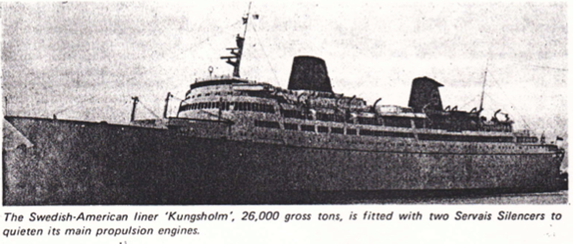Swedish-American Liner ‘Kungsholm 1953.
After the end of World War II the Swedish American Line, the company that had been pioneers of cruising during the 1920s,[8] was left in a difficult situation. MS Stockholm, the large new build that had been planned during the late 1930s, never entered service for them because of the war, with the remaining fleet consisting of ageing ships The company took delivery of their first post-war ship, the fourth MS Stockholm, in 1948. She was a small cargo/passenger liner far removed from the luxury of her pre-war predecessors.]

In 1948, during the same year that the Stockholm was delivered, SAL had already begun market research on both sides of the Atlantic, with the prospect of building a new ship in mind. Based on the results of the research, the company decided to order a 20,000 gross register ton combined ocean liner / cruise ship that could accommodate 802 passengers. After contacting 50 shipyards around the world about the prospects of buildings their new ship, SAL placed an order for their new ship with the De Schelde shipyard in The Netherlands on 1 April 1950.
On 18 October 1952 the new ship was launched and christened MS Kungsholm by Princess Sibylla of Sweden.[ The name "Kungsholm" was a traditional one, having been the name of two previous SAL ships. The newest Kungsholm was delivered to her owners on 30 September 1953.
Service history
As Kungsholm
The brand new Kungsholm set on her maiden voyage from Gothenburg to New York City on 24 November 1953. During her time with the Swedish American Line she was used on transatlantic crossings during the northern hemisphere summer season, and on luxury cruises during the rest of the year. She was a highly successful vessel, and already in September 1954 SAL decided to order a slightly larger ship (eventually named MS Gripsholm) based on the same design from the Ansaldo shipyard in Genoa, Italy to become a running mate for the Kungsholm.
In January 1955 the Kungsholm departed on the first-ever around the world cruise made by a SAL vessel. In May 1957 the new Gripsholm was delivered and entered service alongside the Kungsholm. In 1961 the Kungsholm was drydocked and refitted with stabilizers.
Encouraged by the success of the Kungsholm and Gripsholm, the Swedish American Line placed an order for yet another new ship in August 1963. In preparation for the delivery of the new ship—also named MS Kungsholm—the old Kungsholm was sold to the North German Lloyd in May 1964, with the delivery date set in October 1965. She set on her last transatlantic crossing in SAL colours from New York on 21 August 1965, arriving in Gothenburg on 5 October 1965. Ten days later she was delivered to the North German Lloyd.
As Europa
NGL Europa on the Outer Weser (1966)
Following delivery to the North German Lloyd the Kungsholm was renamed Europa (a traditional name in the NGL fleet), given refit and moved under the West German flag. On 9 January 1966 the Europa set on her first transatlantic crossing for her new owners from Bremen to New York. In NGL service the ship followed a similar arrangement as she had with the Swedish American Line, with transatlantic crossings during the (northern hemisphere) summer and cruises during the rest of the year.
In September 1970 the North German Lloyd merged with the Hamburg America Line (HAPAG) to form Hapag-Lloyd. Hapag-Lloyd decided to abandon transatlantic service in 1971, and from there on the Europa was used exclusively for cruising. In either 1971 or 1972 she was re-painted in the new Hapag-Lloyd livery.
As the 1970s were drawing to a close, Hapag-Lloyd started planning a new ship to replace the Europa, also to be named MS Europa. With the delivery date of the new Europa set in December 1981, the old Europa was sold to Independent Continental Lines, a subsidiary of Costa Cruises, with a delivery date in November 1981.
As Columbus C.
Following the sale to Independent Continental Lines, the Europa was renamed Columbus C., painted in Costa Cruises colours and set in cruise traffic. Her career with Costa was short however, as on 29 July 1984 the Columbus C. accidentally rammed a breakwater near Cadiz, Spain. Her keel was badly damaged in the collision, but the ship managed to reach the port of Cadiz under her own power. Her passengers and crew were evacuated, but the ship continued sinking, listing to starboard side. She eventually sank to the bottom of the shallow harbour, remaining only partially submerged.
On 1 November 1984 the Columbus C. was refloated and laid up. The damages were judged to be too severe to be repaired with acceptable costs, and she was sold to Mirak SA in Barcelona to be scrapped. On 2 April 1985 the Columbus C. arrived in Barcelona under tow, where she was scrapped.
